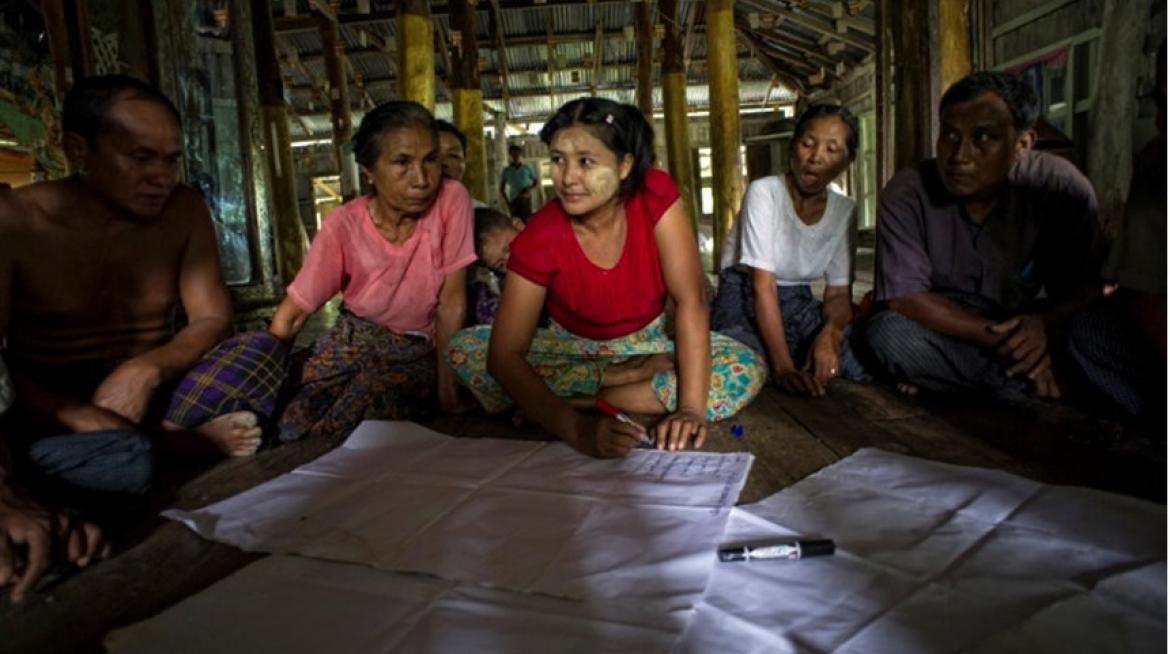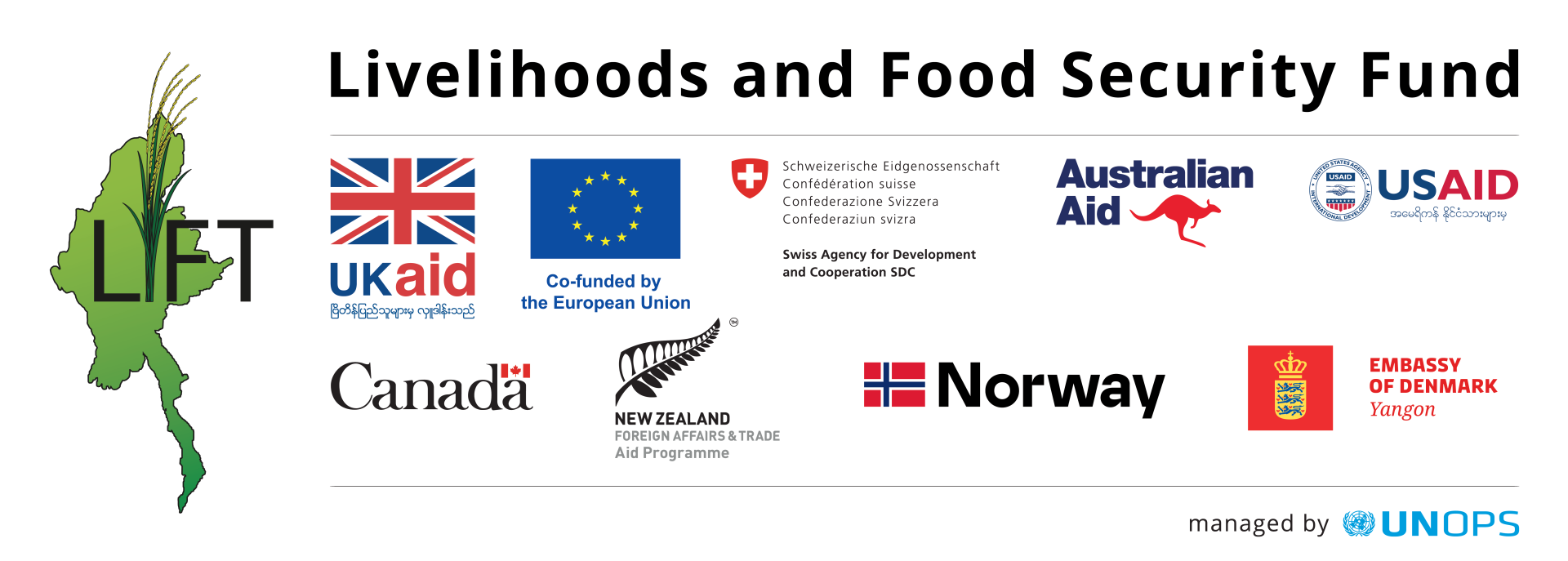
The Tat Lan Programme in Rakhine is guiding vulnerable communities to be better prepared for the effects of cyclones and flooding. Jennifer Macintyre, Tat Lan's Communications Officer, describes how one community has taken matters into its own hands.
-----
Last week, Ma Thein Hlaing and 27 other members of the Yan Htaing Village Development Committee met in their local monastery to develop their own disaster risk reduction strategy.
All 220 houses in their Minbya village were flooded during the recent Cyclone Komen deluge. For two days and nights, the community sheltered in their monastery alongside neighbouring villagers from Myauk Kyein and Lwan Lone Peik.
Ma Thein says they are grateful their monastery is higher than the Minbya to Yangon road that runs down their river shore. “We are normally advised to gather on the roadway during an emergency, but these floods buried our road waist deep in water,” she says. So, this Village Development Committee (VDC) sees their first task being to consult with their township authorities and the Department for Rural Development to have the road raised above flood levels.
The Tat Lan development programme, which is funded by the Livelihood and Food Security Trust Fund, has assisted Yan Htaing to form a VDC. First, the community established livelihood sub-committees: for agriculture, fisheries and aquaculture, infrastructure, nutrition and financial services. These groups each nominated six members, one third of them women, to form the VDC and the community had a mass meeting in the monastery, to elect the chairperson for their community. There were 50 nominations.
“Everyone voted,” says VDC secretary, U Hla Aye. “We want someone who is motivated, who will give time to the public purpose, someone who has the capacity to take a leadership role and importantly, someone who is devoted to our community.”
 U Win Maung, a cash-for-work labourer, paddy farmer and father of the village school teacher was elected as chairman. “I am happy to work for the VDC. I don’t tire easily and I do labour work,” says U Win Maung, who within a month of election, has his community working together building a village information centre, high enough to protect all the village’s important information - something the community realized they needed, as they prepared for possible floods.
U Win Maung, a cash-for-work labourer, paddy farmer and father of the village school teacher was elected as chairman. “I am happy to work for the VDC. I don’t tire easily and I do labour work,” says U Win Maung, who within a month of election, has his community working together building a village information centre, high enough to protect all the village’s important information - something the community realized they needed, as they prepared for possible floods.
Community mobilisation
The Tat Lan governance programme provides leadership and community mobilisation training to VDC members, as well as developing their negotiation, conflict resolution and communication skills.
Cyclone Komen was an opportunity for the Yan Htaing VDC to test these skills. Six VDC members monitored radio stations and used megaphones to inform villagers of the storm’s proximity, where to go and what they needed. To ensure everyone was safe Ma Thein says they organised a ‘care -tree’, a network of people to pass on essential information and make sure all the vulnerable members of their community were safe and prepared for evacuation.
“We moved the disabled people to the monastery early. Women prepared food and stored water in the monastery. Men moved the pigs, buffaloes and cows to the highest ground, and fishermen tied their boats to the shore. We packed all our precious things, National Registration Certificates and other important documents into plastic bags and stored them in high places.”
While people packed the medicine they needed for every day, some children and elderly people became unwell as they huddled together through days and nights of torrential rain. “The rain brought mosquitos in, so we needed malaria medication, and we needed tablets for headaches, diarrhoea, nausea, vomiting and stomach aches. Some children had colds and runny noses, and someone had cuts and sores. We had bandages but no scissors. We had torches but needed more batteries. We had wood, but we needed more matches.”
As they count the costs of the floods the Yan Htaing community are proud to report that they protected all people and moved their livestock to high ground, losing only one cow and some poultry. But, they want to use this experience to do better next time. They now have a list of medicines and supplies to stock in the monastery and their new Village Information Centre.
 The floods heightened their awareness of health needs, and led the VDC to brainstorm and develop a vision for their village. They want to build pit latrines, a medical clinic, and a new school building to educate children beyond Grade 5 – a building that can also be an emergency shelter.
The floods heightened their awareness of health needs, and led the VDC to brainstorm and develop a vision for their village. They want to build pit latrines, a medical clinic, and a new school building to educate children beyond Grade 5 – a building that can also be an emergency shelter.
For the Yan Htaing VDC to realize their vision they will need to advocate to government for financial support while mobilising themselves to do the manual work. “We will all bring our gifts and work hard,” says U Win Maung. “I believe I can communicate with government officials and departments now. They are more flexible now than in the past.”
Ma Thein Hlaing agrees. As a child at school she dreamed about being a lawyer. “I wanted to help villagers as a lawyer, and I wanted to share the real experience of village life with township authorities, the National and Union Government,” she says.
Unfortunately, her parents could not afford to send her away for high school. Today, this 34-year-old mother recognizes that she has another opportunity to fulfil her dream, as a member of the Yan Htaing VDC. “This is really matching my dream. I would like to encourage my community through all their different challenges and speak up for them, so authorities can understand our struggles.”
Ma Thein smiles as she looks at her five-year-old daughter, Soe Na San, and she nods her head. She wants a high school in Yan Htaing village, and is investing her savings in the village savings and loans association, so she can afford to educate her daughter and break the poverty cycle.
 The Tat Lan consortium of INGOs includes IRC, Save the Children, Oxfam, CARE International, and Better Life Organisation. The programme is funded by LIFT.
The Tat Lan consortium of INGOs includes IRC, Save the Children, Oxfam, CARE International, and Better Life Organisation. The programme is funded by LIFT.


